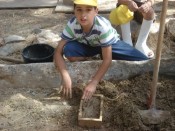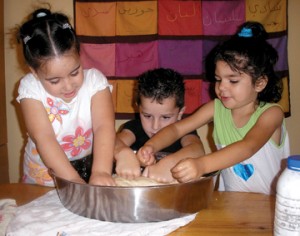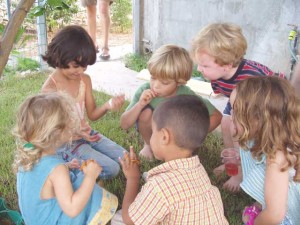Waldorf News
Shalaam Shalom: Teaching children in the Middle East pathways to peace

In Shfar’am, a lower Galilee city of over 30,000 Muslim, Christian and Druze Arab inhabitants, the first Arab Waldorf school, El Zeitoun, The Olive Tree, came into being because of Lana Nasrallah and other like-minded parents, who believed that an education for their children which embodies universal human values could become a unifying force in a society torn by a century of bloodshed and mistrust.
El Zeitoun represents an exciting new educational direction arising from an inspired and empowered Arab community. According to Lana, El Zeitoun exists today because of Arab families dedicated to the welfare of their children: “A group of us gathered together looking for alternative education for our children. In almost every case, it was the mother who swayed the choice to put her child into El Zeitoun.”
From its inception, El Zeitoun was a catalyst for bridging Shfar’am with the neighboring Jewish community at Kibbutz Harduf. Lana and other El Zeitoun teachers collaborated with teachers at the Harduf Waldorf school in order to create an effective and comprehensive curriculum, including joint activities for their classes.
This year, Lana’s class started the fourth grade. As she has done each year since her first kindergarten class, she breaks new ground by developing an Arab Waldorf curriculum for the next grade level that incorporates the seasonal celebrations of her Muslim, Christian and Druze students. El Zeitoun, again, is a bridge-building catalyst, bringing all three faiths of its community together in one classroom.
 The existence of El Zeitoun is testimony to the resourcefulness, determination and dedication of this small but vibrant Waldorf community. These qualities have enhanced their resilience in confronting and overcoming significant obstacles. This year alone, El Zeitoun negotiated with the city of Shfar’am for permission to continue occupancy of the community building, so as not to be evicted before the end of the school year. Seeking a more stable long-term location, they miraculously raised the funds necessary to build their new school building on land leased to them by an El Zeitoun parent. After a summer of community hands-on participation in the building process, the school triumphantly took occupancy of its newly completed structure this fall semester.
The existence of El Zeitoun is testimony to the resourcefulness, determination and dedication of this small but vibrant Waldorf community. These qualities have enhanced their resilience in confronting and overcoming significant obstacles. This year alone, El Zeitoun negotiated with the city of Shfar’am for permission to continue occupancy of the community building, so as not to be evicted before the end of the school year. Seeking a more stable long-term location, they miraculously raised the funds necessary to build their new school building on land leased to them by an El Zeitoun parent. After a summer of community hands-on participation in the building process, the school triumphantly took occupancy of its newly completed structure this fall semester.
A NEW GENERATION OF COMPASSIONATE YOUTH VOLUNTEERS
Last year an astounding 58% of graduates from Harduf Waldorf High School (approximately 40 students) signed up to perform an extra year of volunteer community service (“Shnat Sherut”) to work with Jewish and Arab individuals who are homeless, drug-addicted, or orphaned in comparison with 2% of Jewish high school graduates. Waldorf school graduates from Israel testify that the values they received in school had a major influence on their decision to do volunteer service in the community.
WALDORF SCHOOLS ARE RAPIDLY GROWING IN ISRAEL
In Israel the number of schools using Waldorf educational techniques has been steadily increasing in Jewish communities since 1989 when the first school started with 13 children. Today there are more than 4,000 children in 16 Waldorf schools throughout Israel. Additionally, there over 100 kindergartens, and three Waldorf high schools opened in Israel during the 2009-2010 school year. The student growth rate is over ten percent per year.
HELPING CHILDREN LIVING UNDER THE CHRONIC STRESS OF CONFLICT
In 2003, 42% of all children in Israel suffered post-traumatic stress disorder, the same syndrome seen in soldiers returning from war. Waldorf education integrates the relaxation response into the class curriculum to help children de-stress while they learn in a cooperative rather than competitive environment.
CO-SPONSOR OF TWO PEACE EDUCATION PILOT SCHOOLS
Ein Bustan, Spring in the Garden, is the first integrated Jewish/Arab Waldorf kindergarten in Israel. It is situated in the Arab village of Hilf, near Kiryat Tivon, in the lower Galilee. Ein Bustan operates two kindergartens/schools: a preschool for the youngest children, ages 2-4, and a kindergarten for the older children, ages 4-7.The children of “Ein Bustan” (meaning “spring in the garden”) come from Kiryat Tivon, (a Jewish town) and the surrounding Bedouin (Arab) villages Hilf, Zbidat, Zarzir and Bosmat Tab’un
El Zeitoun, this Arab Waldorf School in Israel, provides a model for Palestinians in the West Bank on how Waldorf education can be integrated into an Arab culture based on Muslim values. Because of the numerous Waldorf schools in the Jewish communities in Israel and the education’s emphasis on universal human values, Israeli and Palestinian educational communities involved in the Waldorf approach can find a common ground for joint cooperation as they strive together to educate their students.
El Zeitoun is developing a Friendship Bridge Program with the nearby Jewish Waldorf school, Harduf. By sharing cultural events and day trips, these schools help develop intercultural connections, including shared values with a focus on conflict resolution.
 ISRAELI AND PALESTINIAN EDUCATORS WORKING TOGETHER FOR A NEW FUTURE
ISRAELI AND PALESTINIAN EDUCATORS WORKING TOGETHER FOR A NEW FUTURE
In phase II of Salaam Shalom’s Training program, Waldorf teachers Stafanie Allon and Amina Sawaed travel weekly from Israel into the West Bank to mentor Palestinian kindergarten teachers at the Jenin Charitable Society. The Palestinian teachers learn how to create a warm and nurturing classroom and how, through stories and other activities, they can teach respect for all human beings. There are 6 kindergarten classes at the Jenin Charitable Society, with about 25 children in each, who are benefiting from this training. Stefanie Allon started the first Waldorf kindergarten in Israel in 1989. She also helped start the Arab Waldorf Teacher Training and El Zeitoun. Amina Sawaed is the daughter of the respected Bedouin sheik, Abu Amin, a leader of over 40,000 Bedouins in the Galilee. Amina Sawaed is a teacher in the El Zeitoun Waldorf kindergarten in the Galilee.
PAST ACTIVITIES
Salaam Shalom Educational Foundation’s first phase included conflict resolution training for faculty and teens in Israel, support for the Palestinian Teacher Training, and support for a high school peace leadership program in the Galilee. The high school program was a two-pronged educational model promoting Jewish and Arab coexistent participation in Israeli society while addressing the high drop out rate and low performance for matriculation of Israeli-Arab high school students from a public high school.
Though the high school program in itself was successful, there were two critical observations. One observation was that the educational gap between Jewish and Arab high school students was too large to try to effectively remediate at such a late stage of development. It was far more productive to support an equal education for both Jewish and Arab students from the earliest years. It was important for the Jewish and Arab communities to share a common goal in which they could work together to achieve.
B ecause of the unprecedented growth of Waldorf education in the Jewish community and the nascent development within the Arab community, it was decided that the most effective intervention for equal opportunities in education in Israel while promoting the long term development of a culture of peace in the region, was to support two pilot education programs, Ein Bustan, the first Arab/Waldorf kindergarten in Israel and El Zeitoun, the first Arab Waldorf School in Israel. Both of these programs, along with the Palestinian Teacher Training have a high potential for positively impacting society in the Middle East. All of this supports an education for both Jewish and Arab children in the Middle East that heals while promoting new capacities toward building a peaceful and prosperous future.
ecause of the unprecedented growth of Waldorf education in the Jewish community and the nascent development within the Arab community, it was decided that the most effective intervention for equal opportunities in education in Israel while promoting the long term development of a culture of peace in the region, was to support two pilot education programs, Ein Bustan, the first Arab/Waldorf kindergarten in Israel and El Zeitoun, the first Arab Waldorf School in Israel. Both of these programs, along with the Palestinian Teacher Training have a high potential for positively impacting society in the Middle East. All of this supports an education for both Jewish and Arab children in the Middle East that heals while promoting new capacities toward building a peaceful and prosperous future.
As each challenge confronts the El Zeitoun community, they rally their indomitable spirit and ingenuity to conquer obstacles and continue building the path of their dream. The most recent and daunting obstacle comes in the form of stalled funding from the Israeli Ministry of Education, as El Zeitoun awaits the issuance of its new permit. This means that they currently do not have the resources to pay their teachers’ salaries or monthly utility bills and supply costs.
El Zeitoun needs help. Alone, they cannot find the funds they need from their already depleted resources. Their dream of a resilient and vital community can only thrive with the continued outpouring of support through donations.
El Zeitoun literally means The Olive Tree. The olive branch is a symbol for peace in the Middle East. This little Olive Tree, El Zeitoun, is growing from a sapling into a grove large enough to someday spread peace throughout the whole Middle East.
“Knitting is more important than handwork” Waldorf in the Huffington Post!
“Old fashioned play builds serious skills”
 Space speaks. Its language is movement.
Space speaks. Its language is movement. Training in Traumatology & Artistic Therapies
Training in Traumatology & Artistic Therapies Preparing Teachers for 2024-25 Grades 1-8
Preparing Teachers for 2024-25 Grades 1-8 Grade Level Training in Southern California
Grade Level Training in Southern California Middle School Science With Roberto Trostli
Middle School Science With Roberto Trostli Bay Area Teacher Training
Bay Area Teacher Training Transforming Voices Worldwide
Transforming Voices Worldwide Full-Time Teacher Education
Full-Time Teacher Education Great books for Waldorf Teachers & Families
Great books for Waldorf Teachers & Families Summer Programs - Culminating Class Trips
Summer Programs - Culminating Class Trips Grade-specific web courses for teachers
Grade-specific web courses for teachers The Journey is Everything
The Journey is Everything Train to Teach in Seattle
Train to Teach in Seattle Caring for All Stages of Life
Caring for All Stages of Life Flexible preparation for your new grade
Flexible preparation for your new grade Waldorf Stories for Everyone
Waldorf Stories for Everyone Jamie York Books, Resources, Workshops
Jamie York Books, Resources, Workshops Everything a Teacher Needs
Everything a Teacher Needs Roadmap to Literacy Books & Courses
Roadmap to Literacy Books & Courses Waldorf Training in Australia
Waldorf Training in Australia ~ Ensoul Your World With Color ~
~ Ensoul Your World With Color ~ Quality Education in the Heartland
Quality Education in the Heartland Immersive Academics and Arts
Immersive Academics and Arts Waldorf-inspired Homeschool Curriculum
Waldorf-inspired Homeschool Curriculum Association for a Healing Education
Association for a Healing Education Bringing Love to Learning for a Lifetime
Bringing Love to Learning for a Lifetime RSS Feeds
RSS Feeds